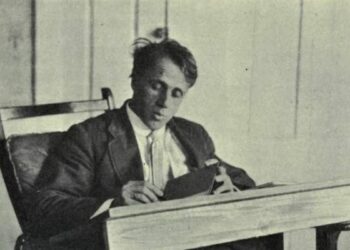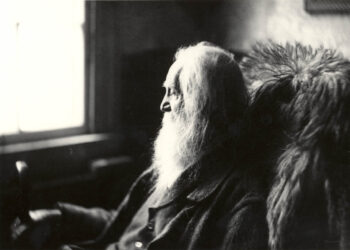Table of Contents
ToggleIntroduction
Summary of Crossing Brooklyn Ferry By Walt Whitman “Crossing Brooklyn Ferry” is a poem by Walt Whitman that reflects the poet’s deep connection to both the physical and metaphysical aspects of existence. Written in 1856 and included in his groundbreaking collection Leaves of Grass, the poem encapsulates Whitman’s transcendental philosophy and his belief in the interconnectedness of all humanity. Through his vivid imagery and contemplative style, Whitman invites readers to reflect on their own experiences, emotions, and relationships as they navigate the journey of life.
The poem captures a ferry ride across the East River, serving as both a literal and metaphorical crossing. It explores themes of time, memory, identity, and the eternal bond shared among individuals, transcending the barriers of time and space. Whitman’s characteristic free verse style allows for a natural flow of thought and emotion, emphasizing the continuity of human experience.Summary of Crossing Brooklyn Ferry By Walt Whitman
In this summary, we will explore the poem’s structure, themes, and literary devices, as well as its significance in Whitman’s body of work and its impact on American literature.
READ MORE
Summary of the Poem
Stanza Breakdown
“Crossing Brooklyn Ferry” consists of several stanzas that unfold the speaker’s experience on the ferry while meditating on broader themes of existence. The poem begins with a vivid description of the ferry ride, setting the scene as the speaker boards the boat and gazes at the surrounding landscape.Summary of Crossing Brooklyn Ferry By Walt Whitman
Stanza 1: The Journey Begins
In the opening lines, the speaker addresses the passengers on the ferry, inviting them to share in the moment of crossing the river. He describes the sights and sounds of the environment, emphasizing the bustling activity of the city and the river itself. The speaker’s keen observations create a rich sensory experience, immersing the reader in the scene.
The speaker acknowledges the passage of time and the cyclical nature of existence. He reflects on the significance of this moment, suggesting that it is not just a ferry ride, but a metaphorical crossing between different states of being. This duality of the experience sets the stage for the poem’s exploration of the relationship between the self and the collective.Summary of Crossing Brooklyn Ferry By Walt Whitman
Stanza 2: Connection Across Time
As the poem progresses, the speaker delves deeper into the theme of connection. He asserts that his thoughts and experiences resonate with those who have crossed the ferry before him and those who will do so in the future. This idea of a shared human experience transcends time, creating a bond among all individuals.
Whitman’s use of the first-person perspective invites readers to empathize with the speaker’s feelings. He expresses a sense of belonging and unity with the other passengers, as well as with people across generations. The speaker’s reflections highlight the continuity of human emotions—joy, sorrow, love, and longing—suggesting that these feelings are universal and timeless.
Stanza 3: The Role of Memory
Memory plays a crucial role in the poem as the speaker navigates his thoughts. He contemplates how memories shape identity and influence one’s perception of the present. The act of crossing the ferry becomes a symbol of the transition from one phase of life to another, evoking the idea that every journey carries the weight of past experiences.
The speaker’s meditation on memory connects the individual to the collective consciousness of humanity. He recognizes that while personal memories may fade, the essence of those experiences remains alive within the larger narrative of existence. This interplay between the individual and the collective reinforces the theme of interconnectedness.Summary of Crossing Brooklyn Ferry By Walt Whitman
READ MORE
Stanza 4: The Nature of Existence
In this stanza, Whitman philosophizes about the nature of existence and the human condition. He grapples with the concept of mortality, acknowledging that life is fleeting and that the ferry ride serves as a reminder of life’s impermanence. However, rather than succumbing to despair, the speaker embraces the beauty of the moment and the potential for connection.
The imagery of the ferry as a vessel of transition encapsulates the idea that life is a continuous journey. Whitman emphasizes the importance of living fully in the present, cherishing each moment as it unfolds. This perspective aligns with the poet’s broader philosophy of celebrating life in all its complexity.
Stanza 5: The Call to Future Generations
The final stanzas express a longing for future generations to recognize and appreciate the shared human experience. The speaker invites others—those who will come after him—to understand the significance of their own crossings and to acknowledge the interconnectedness that binds them to the past and future.
Whitman’s inclusive language creates a sense of universality, as he speaks not only to the passengers on the ferry but also to readers across time. He emphasizes that while individual experiences may differ, the essence of being human is a common thread that unites all people.
Themes
1. Interconnectedness of Humanity
A central theme of “Crossing Brooklyn Ferry” is the interconnectedness of all individuals. Whitman’s exploration of shared experiences emphasizes that despite differences in time, place, and circumstance, humans are bound by common emotions and struggles. This theme reflects Whitman’s belief in the collective consciousness, where each person’s experience contributes to the tapestry of human existence.
2. The Passage of Time
The poem poignantly captures the passage of time, illustrating how moments of life are transient yet significant. Whitman reflects on how experiences shape identity and how memories influence perceptions of the present. The ferry ride serves as a metaphor for life’s journey, highlighting the cyclical nature of existence.Summary of Crossing Brooklyn Ferry By Walt Whitman
3. Memory and Identity
Whitman delves into the role of memory in shaping one’s identity. He suggests that personal memories, while unique, resonate with the collective human experience. The poem emphasizes that memory is not merely a repository of the past but a living, breathing part of who we are, connecting us to others and influencing our understanding of life.
4. Celebration of Life
“Crossing Brooklyn Ferry” celebrates the beauty of life, urging readers to embrace the present moment and appreciate the richness of existence. Whitman’s optimistic perspective encourages individuals to find meaning in their experiences, regardless of life’s challenges. The poem is a testament to the joys and sorrows that define the human experience.
READ MORE
5. Mortality and the Human Condition
Whitman confronts the theme of mortality, recognizing that life is fleeting and that every journey is marked by an awareness of eventual loss. However, instead of dwelling on despair, the poem emphasizes the importance of living fully and finding connection in the face of mortality. This acceptance of the human condition reflects a profound understanding of life’s complexities.
Literary Devices
1. Free Verse
Whitman employs free verse throughout the poem, allowing for a natural flow of thought and emotion. This style mirrors the spontaneity of the ferry ride and reflects the fluidity of human experience. The absence of a rigid structure gives the poem a conversational tone, inviting readers to engage with the speaker’s reflections.Summary of Crossing Brooklyn Ferry By Walt Whitman
2. Vivid Imagery
Whitman’s use of vivid imagery immerses readers in the sensory experience of crossing the ferry. Descriptions of the river, the cityscape, and the passengers create a dynamic setting that enhances the emotional depth of the poem. The imagery serves to evoke feelings of nostalgia, connection, and contemplation.
3. Repetition
Repetition is a key device in “Crossing Brooklyn Ferry,” reinforcing the themes of interconnectedness and continuity. Phrases such as “I too” and “you” emphasize the shared human experience, creating a sense of unity among individuals across time and space. This repetition underscores the poem’s message of collective identity.
4. Personification
Whitman employs personification to imbue the ferry and the river with human qualities, suggesting that they serve as vessels of connection and transition. This technique deepens the metaphorical significance of the ferry ride, transforming it into a symbol of life’s journey and the bonds that unite individuals.
5. Symbolism
The ferry itself serves as a powerful symbol throughout the poem. It represents the transition between different states of being, both literally and metaphorically. The act of crossing the river embodies the journey of life, while the East River becomes a conduit for the exploration of shared experiences and memories.

Conclusion
“Crossing Brooklyn Ferry” stands as one of Walt Whitman’s most significant works, encapsulating his philosophy of interconnectedness and the celebration of life. Through its vivid imagery, contemplative themes, and innovative use of free verse, the poem invites readers to reflect on their own journeys and the shared human experience that transcends time and space.Summary of Crossing Brooklyn Ferry By Walt Whitman
Whitman’s exploration of memory, identity, and mortality resonates deeply, emphasizing the importance of connection in a world that often feels fragmented. The poem serves as a reminder that, despite the passage of time and the inevitability of loss, the bonds forged through shared experiences endure.
In the context of American literature, “Crossing Brooklyn Ferry” exemplifies Whitman’s pioneering spirit and his contribution to the development of modern poetry. His emphasis on individuality, democracy, and the celebration of the human spirit continues to inspire readers and writers alike, solidifying his legacy as one of America’s greatest poets.
FAQ
1. What is the central theme of “Crossing Brooklyn Ferry”?
The central theme of “Crossing Brooklyn Ferry” is the interconnectedness of humanity. Whitman explores how individual experiences resonate across time and space, emphasizing that despite differences, all people share common emotions and struggles.Summary of Crossing Brooklyn Ferry By Walt Whitman
2. How does Whitman use imagery in the poem?
Whitman employs vivid imagery to immerse readers in the sensory experience of crossing the ferry. Descriptions of the river, the city, and the passengers create a dynamic setting that enhances the emotional depth of the poem, evoking feelings of nostalgia and connection.
3. What role does memory play in the poem?
Memory is a crucial theme in the poem, as Whitman reflects on how personal memories shape identity and influence perceptions of the present. He suggests that while memories may fade, their essence contributes to the larger narrative of human experience.
4. How does the poem address the concept of mortality?
Whitman confronts mortality by acknowledging that life is fleeting and every journey is marked by awareness of eventual loss. However, instead of despair, he emphasizes the importance of living fully and finding connection in the face of mortality.
5. What literary devices does Whitman use in “Crossing Brooklyn Ferry”?
Whitman employs various literary devices, including free verse, vivid imagery, repetition, personification, and symbolism. These devices enhance the poem’s emotional depth and reinforce its central themes of interconnectedness and the celebration of life.
6. In what ways does “Crossing Brooklyn Ferry” reflect Whitman’s broader philosophy?
The poem reflects Whitman’s philosophy of interconnectedness and the celebration of individuality. His belief in the collective human experience and the importance of living fully in the present resonates throughout the work, showcasing his commitment to exploring the complexities of the human condition.

















